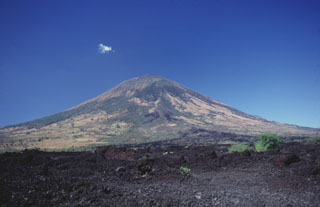Report on San Miguel (El Salvador) — 26 April-2 May 2017
Smithsonian Institution / US Geological Survey
Weekly Volcanic Activity Report, 26 April-2 May 2017
Managing Editor: Sally Sennert.
Please cite this report as:
Global Volcanism Program, 2017. Report on San Miguel (El Salvador) (Sennert, S, ed.). Weekly Volcanic Activity Report, 26 April-2 May 2017. Smithsonian Institution and US Geological Survey.
San Miguel
El Salvador
13.434°N, 88.269°W; summit elev. 2130 m
All times are local (unless otherwise noted)
SNET reported that during 27-28 April RSAM values at San Miguel fluctuated between 106 and 176 units (typical background levels average 50 units). At 1532 on 27 April a strong gas plume rose 1.2 km above the crater rim.
Geological Summary. The symmetrical cone of San Miguel, one of the most active volcanoes in El Salvador, rises from near sea level to form one of the country's most prominent landmarks. A broad, deep, crater complex that has been frequently modified by eruptions recorded since the early 16th century caps the truncated unvegetated summit, also known locally as Chaparrastique. Flanks eruptions of the basaltic-andesitic volcano have produced many lava flows, including several during the 17th-19th centuries that extended to the N, NE, and SE. The SE-flank flows are the largest and form broad, sparsely vegetated lava fields crossed by highways and a railroad skirting the base of the volcano. Flank vent locations have migrated higher on the edifice during historical time, and the most recent activity has consisted of minor ash eruptions from the summit crater.

